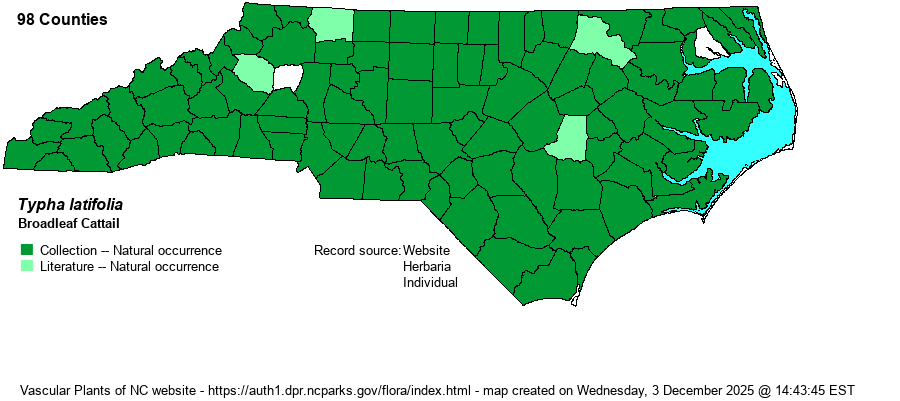| Author | L. | |
| Distribution | Throughout the state, and certainly found in all counties.
This is a very widespread species, across all of southern Canada and the U.S.
| |
| Abundance | Common statewide, being one of the most numerous plants of open, freshwater wetlands. However, it is decidedly uncommon in the Sandhills proper, where true marsh habitats are scarce. | |
| Habitat | This is a characteristic species of freshwater marshes, margins of lakes and ponds, ditches, and other sunny wetlands -- being one of the most common plants of freshwater marshes. Shows a preference for higher nutrient situations. |
| Phenology | Flowers from May to July, and fruits from June to November. | |
| Identification | This familiar marsh species needs no introduction and is familiar to all. The stout stem grows to 4-6 feet tall, with the very long leaves typically somewhat taller than the stem, at 6-7 feet long. The leaves are broader than the other native species, being about 3/4-1-inch wide, and yellow-green to bright green in color. The staminate spike of pale brown flowers comes into contact with the rich brown pistillate spike. In the other two native species, these two spikes are separated on the stem by an inch or more, easily noted when in flower or fruit. The non-native hybrid T. x glauca does occur in the eastern counties. Check Weakley (2018) for distinctions between that taxon with T. latifolia. | |
| Taxonomic Comments | None
| |
| Other Common Name(s) | Common Cattail, Bullrush | |
| State Rank | S5 | |
| Global Rank | G5 | |
| State Status | | |
| US Status | | |
| USACE-agcp | OBL link |
| USACE-emp | OBL link |

